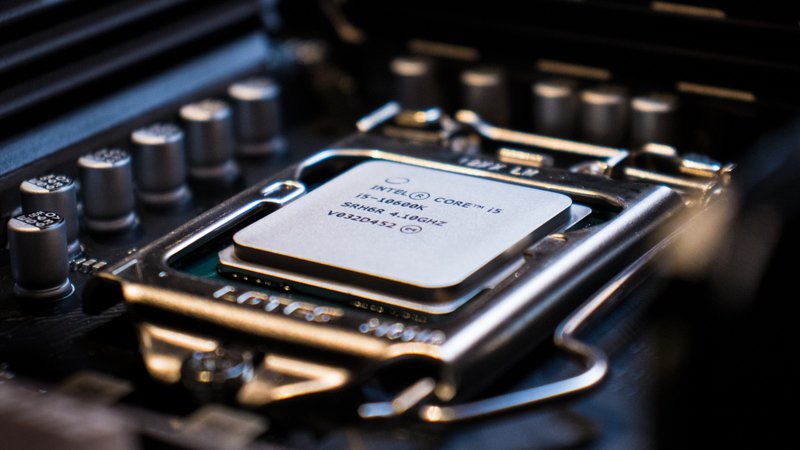What Is Cpu (Central Processing Unit): A Comprehensive Guide

The Central Processing Unit (CPU) is a fundamental component of modern computer systems, responsible for executing instructions and performing calculations.
This comprehensive guide aims to provide an objective and impersonal understanding of the CPU by exploring its functions, components, architecture, and performance.
The article will delve into key concepts such as clock speed, multicore processors, overclocking, cooling techniques, CPU benchmarks, and performance testing.
Additionally, it will offer insights on upgrading your CPU to maximize system performance.
By presenting this information in an academic style devoid of personal pronouns or biases, readers can gain a clear understanding of the CPU’s role in computer processing.
Whether you are a novice seeking basic knowledge or an enthusiast aiming to optimize system capabilities, this guide will serve as a valuable resource in comprehending the intricacies of the CPU.
Key Takeaways
- The CPU is responsible for executing instructions and performing calculations in a computer system.
- Clock speed determines how many cycles per second the CPU can execute, with higher clock speeds indicating faster processing capabilities.
- Different CPU architectures, such as x86, ARM, and PowerPC, have varying performance and power consumption characteristics.
- Multicore processors integrate multiple independent processing units onto a single chip, increasing computational power and multitasking capabilities.
The Functions of a CPU
The CPU is responsible for executing instructions and performing calculations, acting as the brain of a computer system. It carries out a range of functions that are vital for the operation of a computer.
One important function is fetch, where the CPU retrieves instructions from memory. The decode function then interprets these instructions and determines what actions need to be taken.
Next, the execute function performs these actions, which can include arithmetic operations, logical comparisons, and data movement. Finally, the writeback function stores the results of these operations back into memory or registers.
These functions are performed in a continuous cycle known as the fetch-decode-execute cycle, allowing the CPU to rapidly process instructions and perform computations necessary for running software and applications on a computer system.
Components of a CPU
One essential element of a CPU is the control unit, which directs and coordinates the flow of information within the processor. The control unit acts as the brain of the CPU, responsible for fetching instructions from memory, decoding them, and executing them by sending signals to other components.
Another crucial component is the arithmetic logic unit (ALU), which performs mathematical calculations and logical operations. The ALU consists of circuits that can add, subtract, multiply, and divide numbers, as well as compare values for equality or inequality.
Additionally, a CPU contains registers, which are small storage areas used to hold data temporarily during processing. These registers allow for quick access to data needed for immediate calculations or operations.
Overall, these components work together seamlessly to carry out complex computations and perform tasks efficiently within a central processing unit.
Clock Speed and Performance
Clock speed plays a crucial role in determining the performance of a computer’s processor. It refers to the number of cycles per second that the CPU can execute. A higher clock speed generally signifies faster processing capabilities and improved overall performance.
Here are five key points to understand about clock speed and its impact on CPU performance:
- Clock speed is measured in hertz (Hz) and commonly expressed in gigahertz (GHz).
- The CPU executes instructions during each clock cycle, so a higher clock speed means more instructions can be processed within a given time frame.
- However, focusing solely on clock speed may not provide an accurate measure of performance, as other factors like architecture and cache size also influence the overall efficiency.
- Overclocking allows users to increase the clock speed beyond the manufacturer’s specifications, but it can lead to increased heat generation and potential stability issues.
- Different applications have varying degrees of reliance on high clock speeds; tasks involving heavy calculations or data processing may benefit more from CPUs with higher clock speeds than those specializing in multitasking or parallel computing.
CPU Architecture
CPU architecture is a fundamental aspect of computer design that dictates the organization and operation of the various components within the processor. It refers to the structure and layout of the CPU, including its instruction set, registers, cache memory, and data buses. Different CPU architectures offer varying levels of performance, power efficiency, and compatibility with software.
To provide a better understanding of CPU architecture, here is a table summarizing three common architectures: x86, ARM, and PowerPC.
| Architecture | Advantages | Disadvantages |
|---|---|---|
| x86 | Widely supported by software and offers high performance | Can be more power-hungry compared to other architectures |
| ARM | Low power consumption | May not provide optimal performance for certain tasks |
| PowerPC | Efficient in multi-threaded applications | Limited software support |
This table highlights some key advantages and disadvantages associated with each architecture. Understanding these architectural differences can assist in selecting an appropriate CPU for specific computing needs.
Multicore Processors
Multicore processors have revolutionized computer architecture by integrating multiple independent processing units onto a single chip, thereby significantly increasing computational power and overall system performance.
Unlike traditional single-core processors, multicore processors can execute multiple instructions simultaneously, enabling parallel processing and improved multitasking capabilities.
Each core within a multicore processor operates independently and has its own cache memory and control unit, allowing for efficient task distribution and workload management.
The presence of multiple cores also reduces the need for frequent data transfers between the processor and memory, resulting in reduced latency and improved efficiency.
Additionally, multicore processors offer enhanced reliability as tasks can be distributed across different cores, minimizing the impact of failures or errors on the overall system performance.
With their ability to handle complex computations efficiently, multicore processors have become a standard feature in modern computing devices such as desktop computers, laptops, smartphones, and servers.
Overclocking and Cooling
To maximize the performance and prevent overheating of a high-speed processor, it is essential to employ efficient cooling mechanisms that dissipate heat effectively, ensuring stable operation and safeguarding the longevity of the system.
Overclocking, which involves running the CPU at a higher clock speed than its default setting, can significantly enhance processing power but also leads to increased heat generation.
To counteract this, various cooling methods are implemented. Air cooling, using fans and heatsinks, is a common approach for most CPUs. Liquid cooling systems provide more efficient heat dissipation by circulating liquid coolant through pipes or blocks attached to the processor.
Additionally, some enthusiasts use exotic cooling techniques such as phase-change or liquid nitrogen for extreme overclocking scenarios.
Overall, implementing effective cooling solutions helps maintain optimal performance and prevents damage caused by excessive heat buildup in overclocked CPUs.
CPU Benchmarks and Performance Testing
Moving on from the discussion on overclocking and cooling, it is essential to explore CPU benchmarks and performance testing. CPU benchmarks are standardized tests designed to measure a processor’s performance in various tasks such as calculations, data compression, and multimedia processing. These tests provide objective measurements that allow users to compare different CPUs based on their performance capabilities.
Performance testing involves running real-world applications and analyzing how well the CPU handles them. This helps users understand the processor’s efficiency in executing everyday tasks like gaming, video editing, or multitasking. By conducting thorough performance testing, individuals can make informed decisions when selecting a CPU for their specific needs.
To further illustrate this topic, a 3-column and 5-row table can be used to visually present different CPUs along with their benchmark scores across various categories of performance testing.
| Processor | Calculations (score) | Data Compression (score) | Multimedia Processing (score) |
|---|---|---|---|
| CPU A | 85 | 92 | 78 |
| CPU B | 89 | 88 | 82 |
| CPU C | 91 | 90 | 84 |
| CPU D | 87 | 86 | 80 |
| CPU E | 83 | 94 | 79 |
This table offers a clear comparison of CPUs’ benchmark scores across different performance categories, aiding readers in making informed decisions when selecting an appropriate processor for their computing needs.
Upgrading Your CPU
Upgrading the processor in your computer can significantly enhance its performance and allow for smoother execution of demanding tasks. When considering a CPU upgrade, it is important to first assess compatibility with your existing motherboard.
The socket type and chipset of the motherboard must match the new processor you intend to install. Additionally, it is crucial to consider power requirements as some high-performance CPUs may demand more power than your current power supply can provide.
Upgrading the CPU also requires careful consideration of cooling solutions as more powerful processors generate more heat. In some cases, upgrading the CPU may necessitate replacing or upgrading other components such as the heatsink or fan.
Overall, a properly executed CPU upgrade can lead to improved system responsiveness and better multitasking capabilities.
Frequently Asked Questions
What are some common CPU manufacturers and how do they compare in terms of performance and reliability?
Some common CPU manufacturers include Intel, AMD, and ARM. In terms of performance, Intel CPUs are often considered more powerful but also more expensive, while AMD offers a good balance between performance and affordability. ARM CPUs are commonly found in mobile devices and offer energy efficiency. Reliability varies among manufacturers but all have rigorous testing processes to ensure quality.
How does the CPU interact with other hardware components in a computer system?
The CPU interacts with other hardware components in a computer system through various buses and interfaces. It sends and receives data to and from memory, storage devices, input/output devices, and the motherboard to execute instructions and perform calculations.
What factors should be considered when choosing a CPU for a specific purpose, such as gaming or video editing?
Factors that should be considered when choosing a CPU for specific purposes like gaming or video editing include clock speed, number of cores, cache size, and power consumption. These factors impact the CPU’s performance and efficiency in handling demanding tasks.
Are there any limitations or drawbacks to having a higher clock speed in a CPU?
Having a higher clock speed in a CPU can lead to increased power consumption, heat generation, and potential stability issues. Additionally, not all applications can effectively utilize higher clock speeds, limiting the overall performance improvement.
Can a CPU be upgraded or replaced without having to replace other components of a computer system?
Yes, a CPU can be upgraded or replaced without necessarily replacing other components of a computer system. This allows for improved performance, increased processing power, and compatibility with newer technologies without the need for an entirely new system.







